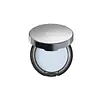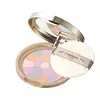What's inside
What's inside
 Key Ingredients
Key Ingredients

 Benefits
Benefits

 Concerns
Concerns

 Ingredients Side-by-side
Ingredients Side-by-side

Talc
AbrasiveCaprylic/Capric Triglyceride
MaskingSilica
AbrasiveMethyl Methacrylate Crosspolymer
Mica
Cosmetic ColorantDimethicone
EmollientNylon-12
Triethylhexanoin
MaskingBoron Nitride
AbsorbentSynthetic Beeswax
Emulsion StabilisingDiisostearyl Malate
EmollientGlyceryl Caprylate
EmollientEthylhexylglycerin
Skin ConditioningCI 77007
Cosmetic ColorantAllantoin
Skin ConditioningPropanediol
SolventPentylene Glycol
Skin ConditioningCI 42090
Cosmetic ColorantTocopheryl Acetate
AntioxidantPinus Sylvestris Leaf Extract
TonicMenthol
MaskingCocos Nucifera Fruit Extract
EmollientTalc, Caprylic/Capric Triglyceride, Silica, Methyl Methacrylate Crosspolymer, Mica, Dimethicone, Nylon-12, Triethylhexanoin, Boron Nitride, Synthetic Beeswax, Diisostearyl Malate, Glyceryl Caprylate, Ethylhexylglycerin, CI 77007, Allantoin, Propanediol, Pentylene Glycol, CI 42090, Tocopheryl Acetate, Pinus Sylvestris Leaf Extract, Menthol, Cocos Nucifera Fruit Extract
Talc
AbrasiveTitanium Dioxide
Cosmetic ColorantEthylhexyl Methoxycinnamate
UV AbsorberMica
Cosmetic ColorantLauroyl Lysine
Skin ConditioningPetrolatum
EmollientSilica
AbrasiveZinc Myristate
Diisostearyl Malate
EmollientVinyl Dimethicone/Methicone Silsesquioxane Crosspolymer
Hydroxyapatite
AbrasiveDipropylene Glycol
HumectantZinc Oxide
Cosmetic ColorantAluminum Hydroxide
EmollientEthylparaben
PreservativeMethylparaben
PreservativeSorbitan Isostearate
EmulsifyingDimethicone
EmollientEthylhexylglycerin
Skin ConditioningCaprylyl Glycol
EmollientWater
Skin ConditioningHydrogen Dimethicone
Sodium Dehydroacetate
PreservativeTin Oxide
AbrasiveDisodium Stearoyl Glutamate
CleansingButylene Glycol
HumectantArgania Spinosa Kernel Oil
EmollientSqualane
EmollientSimmondsia Chinensis Seed Oil
EmollientHydrogenated Polyisobutene
EmollientPropylene Glycol
HumectantBHT
AntioxidantAlcohol Denat.
AntimicrobialSodium Hyaluronate
HumectantPhenoxyethanol
PreservativeSaxifraga Sarmentosa Extract
Skin ConditioningCamellia Sinensis Leaf Extract
AntimicrobialChamomilla Recutita Flower Extract
MaskingRosa Centifolia Flower Extract
AstringentCitric Acid
BufferingSoluble Collagen
HumectantArnica Montana Flower Extract
MaskingHypericum Perforatum Extract
AntimicrobialHedera Helix Leaf/Stem Extract
AntimicrobialAesculus Hippocastanum Seed Extract
Skin ConditioningHamamelis Virginiana Leaf Extract
Skin ConditioningVitis Vinifera Leaf Extract
Skin ConditioningSodium Citrate
BufferingCI 77491
Cosmetic ColorantCI 77492
Cosmetic ColorantCI 73360
Cosmetic ColorantCI 19140
Cosmetic ColorantCI 77007
Cosmetic ColorantTalc, Titanium Dioxide, Ethylhexyl Methoxycinnamate, Mica, Lauroyl Lysine, Petrolatum, Silica, Zinc Myristate, Diisostearyl Malate, Vinyl Dimethicone/Methicone Silsesquioxane Crosspolymer, Hydroxyapatite, Dipropylene Glycol, Zinc Oxide, Aluminum Hydroxide, Ethylparaben, Methylparaben, Sorbitan Isostearate, Dimethicone, Ethylhexylglycerin, Caprylyl Glycol, Water, Hydrogen Dimethicone, Sodium Dehydroacetate, Tin Oxide, Disodium Stearoyl Glutamate, Butylene Glycol, Argania Spinosa Kernel Oil, Squalane, Simmondsia Chinensis Seed Oil, Hydrogenated Polyisobutene, Propylene Glycol, BHT, Alcohol Denat., Sodium Hyaluronate, Phenoxyethanol, Saxifraga Sarmentosa Extract, Camellia Sinensis Leaf Extract, Chamomilla Recutita Flower Extract, Rosa Centifolia Flower Extract, Citric Acid, Soluble Collagen, Arnica Montana Flower Extract, Hypericum Perforatum Extract, Hedera Helix Leaf/Stem Extract, Aesculus Hippocastanum Seed Extract, Hamamelis Virginiana Leaf Extract, Vitis Vinifera Leaf Extract, Sodium Citrate, CI 77491, CI 77492, CI 73360, CI 19140, CI 77007
Ingredients Explained
These ingredients are found in both products.
Ingredients higher up in an ingredient list are typically present in a larger amount.
This pigment is called Ultramarine blue lazurite. It gives a saturated blue color, but can be used to create other colors as well.
According to the manufacturer, it is usually made from kaolin, sodium sulfate, sodium carbonate, sulfur, and charcoal.
Diisostearyl Malate is an emollient and most often used in lip products. It comes from isostearyl alcohol, a fatty acid, and malic acid, an AHA.
As an emollient, Diisostearyl Malate helps create a thin film on your skin to trap moisture in. This helps keep your skin soft and smooth.
Dimethicone is a type of synthetic silicone created from natural materials such as quartz.
What it does:
Dimethicone comes in different viscosities:
Depending on the viscosity, dimethicone has different properties.
Ingredients lists don't always show which type is used, so we recommend reaching out to the brand if you have questions about the viscosity.
This ingredient is unlikely to cause irritation because it does not get absorbed into skin. However, people with silicone allergies should be careful about using this ingredient.
Note: Dimethicone may contribute to pilling. This is because it is not oil or water soluble, so pilling may occur when layered with products. When mixed with heavy oils in a formula, the outcome is also quite greasy.
Learn more about DimethiconeEthylhexylglycerin (we can't pronounce this either) is commonly used as a preservative and skin softener. It is derived from glyceryl.
You might see Ethylhexylglycerin often paired with other preservatives such as phenoxyethanol. Ethylhexylglycerin has been found to increase the effectiveness of these other preservatives.
Mica is a naturally occurring mineral used to add shimmer and color in cosmetics. It can also help improve the texture of a product or give it an opaque, white/silver color.
Serecite is the name for very fine but ragged grains of mica.
This ingredient is often coated with metal oxides like titanium dioxide. Trace amounts of heavy metals may be found in mica, but these metals are not harmful in our personal products.
Mica has been used since prehistoric times throughout the world. Ancient Egyptian, Indian, Greek, Roman, Aztec, and Chinese civilizations have used mica.
Learn more about MicaSilica, also known as silicon dioxide, is a naturally occurring mineral. It is used as a fine, spherical, and porous powder in cosmetics.
Though it has exfoliant properties, the function of silica varies depending on the product.
The unique structure of silica enhances the spreadability and adds smoothness, making it a great texture enhancer.
It is also used as an active carrier, emulsifier, and mattifier due to its ability to absorb excess oil.
In some products, tiny microneedles called spicules are made from silica or hydrolyzed sponge. When you rub them in, they lightly polish away dead skin layers and enhance the penetration of active ingredients.
Learn more about SilicaTalc is a clay mineral. It helps absorb moisture and improve the texture of products. Like other types of clay, Talc can have a slight exfoliating effect on skin. Talc can be added to increase the volume of products.
Some Baby powders are made by combining talc with corn starch. The word "talc" comes from Latin and originates from Arabic. Talc is a mineral commonly found throughout the world.
If you have any concerns about using talc, we recommend checking out the FDA's official page.
Learn more about Talc